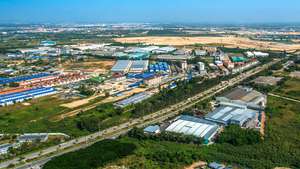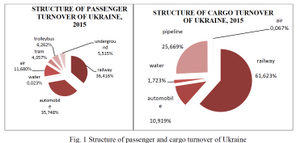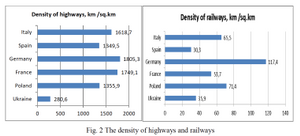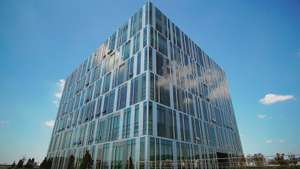
Land resources for the construction of transport facilities.
 Olga Petrakovska 1,
Olga Petrakovska 1,
Mariia Mykhalova 2*
1,2Land Management and Cadastre Department of Kyiv National University of Construction and Architecture, Povitroflotskyi Avenue 31, Kyiv-037, 03037, Ukraine
Received: 11/10/2017, Accepted: 12/10/2017, Available online: 12/28/2017.
DOI: https://doi.org/10.32557/useful-1-2-2017-0005
HDL: http://hdl.handle.net/20.500.12334/38
*Corresponding author: e-mail: petrakovskaolga@gmail.com
Under a creative commons license. Volume 1, Issue 2, 2017, pages: 36-42.
Author Keywords: transport facility, land resources, compulsory purchase, private ownership.
Abstract:
The problems and the tasks of land provision for construction of transport facilities which are recognized as «public need» are analyzed in the article. The study also illustrates the peculiarities of Ukraine in the development of transport and the importance of road and rail transport for the economy. The specifics of the construction of road and railway transport objects consist of their large lengths and the need for a huge number of land plots of private property to be bought.
In the article, the method construction of transport facilities with land compulsory purchase is proposed. This method is based on the generalized foreign experience on compulsory purchase and Ukrainian legal regulations and existing practice of transport facilities construction in urban condition and natural environment.
1. Introduction
The process of globalization has begun in the late twentieth century. It has affected all aspects of public life in the world. Ukraine has entered era of globalization, already as an independent country. New quantitative and qualitative characteristics are inherent for today's international relations. First of all, it concerns the political and economic spheres.
For Ukraine could be highlight the main directions of common integration processes in the world: international trade, capital flows, migration of population and other transnational activities. Improvement of transport facilities is recognized as one of the main direction of the state policy on integration processes ensuring, in particular the development of all modes of transport.
2. Presentation of main study
According to official data of State Statistics of Ukraine, the share of road and rail transport in the total passenger turnover and cargo turnover of Ukraine is 72%. In fact, today 2/3 of all traffic in Ukraine is carried out by roads and rails.

Comparison of indicators of the length and density of roads and railways in the European Union and Ukraine was made. The analysis illustrates that the development of roads and railway tracks in Ukraine is several times smaller than in Spain, Italy, Germany, Poland, France.

Under such conditions, construction of transport facilities of various categories takes on special significance. There is a need to transform the existing approaches, norms and standards in Ukraine when construction of transport facilities, which are recognized as a "public need". It's caused by today's conditions of integration processes. So harmonization of Ukrainian legislation and practice issues to European standards is one of the key tasks.
Under the conditions of the development of the private property institution, there are a lot of problems and tasks which are not regulated in Ukraine as a young sovereign state. The experience of land use management, in various forms of ownership, began to be acquired in fact at the beginning of the XXI century. Up to now there is need to address the following issues:
- expediency of giving and receiving the land to a investor for the construction of transport facilities;
- substantiation and realization of full or partial compulsory purchase for state and communal needs;
- determining the validity and legality of damages and their amounts;
- provision of guarantees of land ownership / use and construction objects, etc.
Existing mechanisms often lead to decisions that are not always open, understandable and, more over optimal. The principles of ensuring rational land use by making decisions on the land use, the land plots alienation, transfer of ownership should be such as to maximize investment in land and increase social security population and economic efficiency.
The methods and means of regulating these issues, first of all, should work to improve the life of the population, increase the land value, increase their investment attractiveness and guarantee the rights regardless of ownership.
We researched and analyzed normative-legal regulation and practical implementation of the transport facilities construction as a public need in existing urban planning conditions and the natural environment [5,6,7,9,11]. Analysis illustrates the existence of two options for solving this issue:
- the location of the linear transport facility is determined in the approved spatial planning documentation;
- the location of the linear transport facility is not set in the approved spatial planning documentation.
In the first case, the calculation of technical and economic indicators actually occurs during the project design development. In this case, the investor may establish a list of land plots that must be purchased and determine the total investment amount in construction, taking into account compensation cost to land owners/users.
At the same time, it should be noted that the normativelydefined estimation when the project design includes all the costs of compulsory purchase [12]. However, the development of project design and the drawing up of a final estimation with the purpose of substantiating investments is not feasible and effective.
In the second case in addition to the measures approved in the spatial planningdocumentation, its implementation in practice takes place under another scheme. Initially, alternative variants of the railway tracks of transport facilities are being developed and their feasibility study is carried out, which includes the compulsory purchase costs. This allows determining the proportion of costs and compensation to owners and the effectiveness of the selected route.
The maximum part of reimbursements to land owners, in the total investment in the project, could be different depends on projects particularities. It depends on investor paying capacity, the complexity of the facility, the term of self-retention and profitability. There are a large number of additional administrative approvals, consents and validations which often lead to unnecessary time and increasing violations of the rights holders.
It is important to note that the compulsory purchase affects not only the financial issues of compensation for damages and property rights, but more or less important, the psychological consequences of forced action to land owner. Whatever social groups the owners belong to, they are still linked by certain connections with the environment in which they live: work, rest (in the case of residential property), producers with connections with suppliers and consumers (in the case of industrial property) etc.
Psychologists say: membership in a community is a natural necessity for every person. When a person is forced to change his habitat for reasons of alienation of property, this leads to certain psychological consequences. Therefore, when choosing a variant of transport facilities location that requires the compulsory purchase of a large number of land plots, with their identical spatial planning value should be selected option where the smallest number of land plots must be compulsory purchased.
We propose the following sequence of public needs provision by necessary land resources with the compulsory purchase using in case of discrepancy of transport facilities providing with the needs of society.
1. Stage. Development of alternative options transport facility location:
1.1.Determination of the peculiarities of natural conditions and the list of spatial planning requirements in the designing area and working out of variants of transport facilities location;
1.2. Comparison and selection of options that meet spatial planning requirements and natural conditions;
1.3. Publication and public discussion of the selected project decision for clarification and correction of the final version.
2. Stage. Establishing the location of transport facility and its legalization:
2.1. Choice of options based on legal requirements and conditions;
2.1.1. Assessment of legal grounds for implementation of project decisions;
2.1.2. Determination of land plots which must be fully or partly compulsory purchased and analysis of their qualitative and quantitative characteristics;
2.1.3. Preliminary estimation of compensation costs when introducing transport facility;
2.1.4. Analysis of the consent of landowners / users and necessary legal transactions and administrative procedures;
2.2. Assessment of environmental impacts;
2.3. Correcting compensation costs and other expenses;
2.4. Comparison of alternatives variants and selection the optimal;
2.5. Approval / adjustment of spatial planning documentation.
3. Stage. Compulsory purchase
3.1. Agreement on the value of land plot and the size of the redemption price;
3.2. Prepare purchase agreement / exchange;
3.3. Development of land management documentation.
4 Stage. Registration of new land rights and use.
5 Stage. Transport facility construction:
5.1. Development and approval of project design;
5.2. Carry out of preparatory works;
5.3. Carry out of construction work;
5.4. Putting into operation of transport facility.
6. Stage. Registration of property rights on constructed transport facilities.
Firstly, it is necessary to compare alternative variants and to choose the optimal location of the transport facility from the point of view of economic feasibility, social efficiency and environmental sustainability, and respect for the rights of parity. And only after that it would be appropriate to make adjustments or to approve spatial planning documentation at the local level.
The proposed in the article stage 2 is not legally defined in Ukraine. But the introduction of this stage would allow making the rational decisions on the location of the linear transport facility before the approval of spatial planning documentation.
The problems that arise at the current stage in the construction of the public utility needs in Ukraine must be resolved by the time of the alienation itself, as outlined in step 2. Implementation of the measures under stage 2 is actually aimed at protecting the rights of investment and rights of land owners/users.
The proposed method is based on the generalized foreign experience on compulsory purchase, the existing experience of the practical implementation of transport facilities in urban conditions and the natural environment.
Conclusions
Nowadays, the application of the method of compulsory purchase is characterized by a specific set of design work, financial arrangements, administrative procedures and legal transactions which are inextricable.
There is no clear sequence of implementation of above mentioned procedures for today. This leads to the difficulty of tracking the legitimacy of certain processes. For example, for today there is no official information about compulsory purchase for public needs. The compliance with rules of the compulsory purchase process as a clear system of interconnected, consistent actions by all interested parties will lead to the transparency and democratic nature of this process.
References
[1] “Composition and content of the detailed plan of the territory.” - SBN Б.1.1-14:2012 [Electronic resource]. – Access mode: http://dbn.at.ua/load/normativy/dbn/1-1-0-1027.
[2] “Composition and content of the general plan.” - SBN Б.1.1-15:2012 [Electronic resource]. – Access mode: http://dbn.at.ua/load/normativy/dbn/1-1-0-1040.
[3] “Composition and content of the project design documentation.” - SBN А.2.2.3-2014 [Electronic resource]. – Access mode: http://dbn.at.ua/load/normativy/dbn/dbn_a_2_2_3_2014/1-1-0-1168.
[4] “On land valuation.” - Law of Ukraine № 1378-IV, 11.12.2003 [Electronic resource]. – Access mode: http://zakon2.rada.gov.ua/laws/show/1378-15.
[5] “On the land alienation, other objects that are located on them, which are in private ownership, for public needs or from the motives of public necessity.” - Law of Ukraine № 1559-VI, 17.11.2009 [Electronic resource]. – Access mode: http://zakon0.rada.gov.ua/laws/show/1559-17.
[6] “On the regulation of spatial planning activities.” - Law of Ukraine № 3038-VI, 17.02.2011 [Electronic resource]. – Access mode: http://zakon2.rada.gov.ua/laws/show/3038-17.
[7] “On the state land cadaster.” - Law of Ukraine № 3613-VI, 07.07.2011 [Electronic resource]. – Access mode: http://zakon2.rada.gov.ua/laws/show/3613-17.
[8] “On the state registration of real estate right and their encumbrances.” - Law of Ukraine № 1952-IV, 01.07.2004 [Electronic resource]. – Access mode: http://zakon3.rada.gov.ua/laws/show/1952-15.
[9] Olga Petrakovska, Mariia Mykhalova. “The role of land compulsory purchase in engineering and transport infrastructure development” - MOTROL. – 2015, Vol.17, No. 8, – P. 103-109.
[10] Olga Petrakovska, Mariia Mykhalova. “The structural-functional model of ensuring interests balance during land compulsory purchase.” - Urban and territorial planning: Scientific and Technical Proceedings. – К., KNUCA, 2017. – № 64. – С.290-296.
[11] Petrakovska O., Tatsiy Yu. “Real Estate Development and Sustainable Urban Development.” – К.: Publishing house "Kyy", 2015. – 504 с.
[12] “Rules for determining the construction cost SSU B D.1.1-1:2013.” - [Electronic resource]. – Access mode: http://dbn.at.ua/load/normativy/dstu/dstu_b_d_1_1_1_2013/5-1-0-1113.
Please cite as: O.Petrakovska, M.Mykhalova “Land resources for the construction of transport facilities.” USEFUL online journal, vol. 2, no. 1, pp. 36–42, December 2017. DOI: https://doi.org/10.32557/useful-1-2-2017-0005








Comments